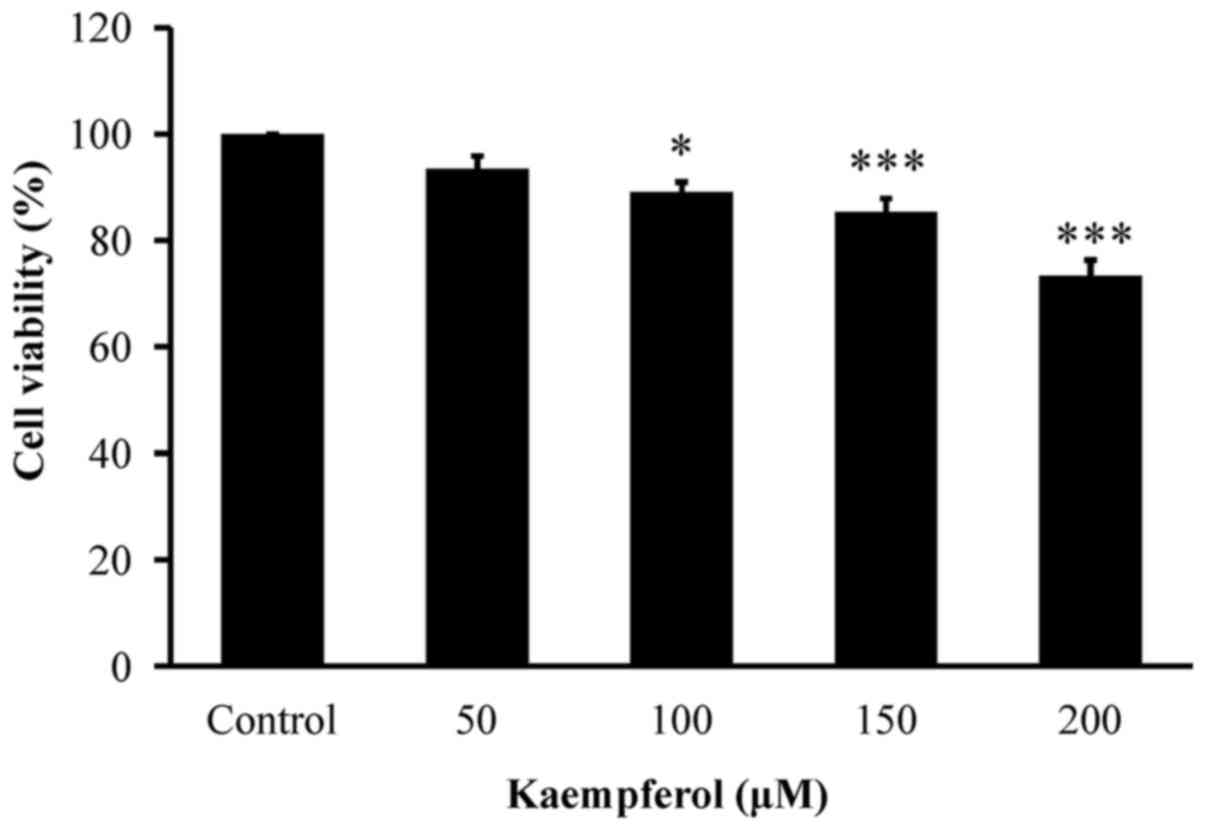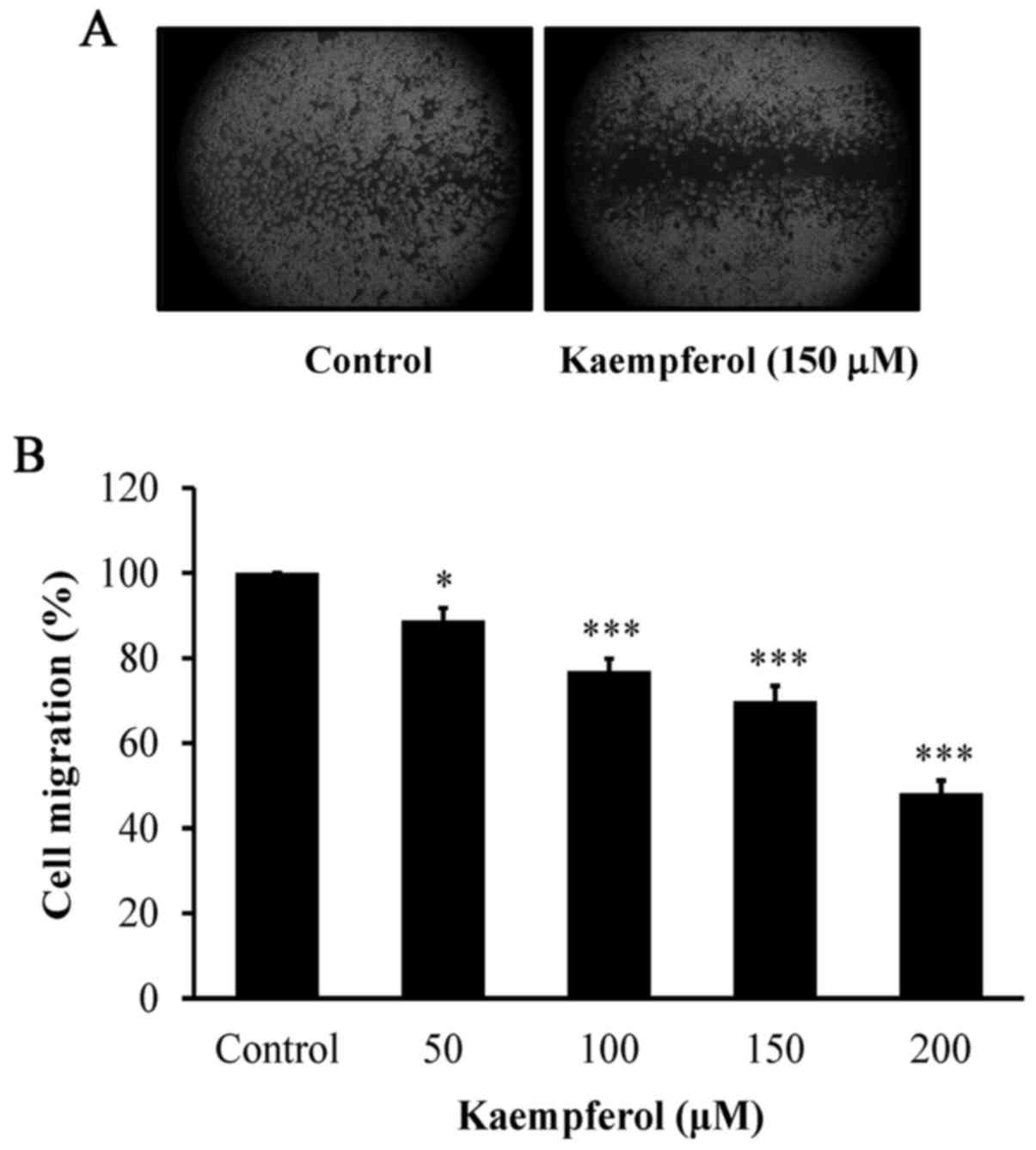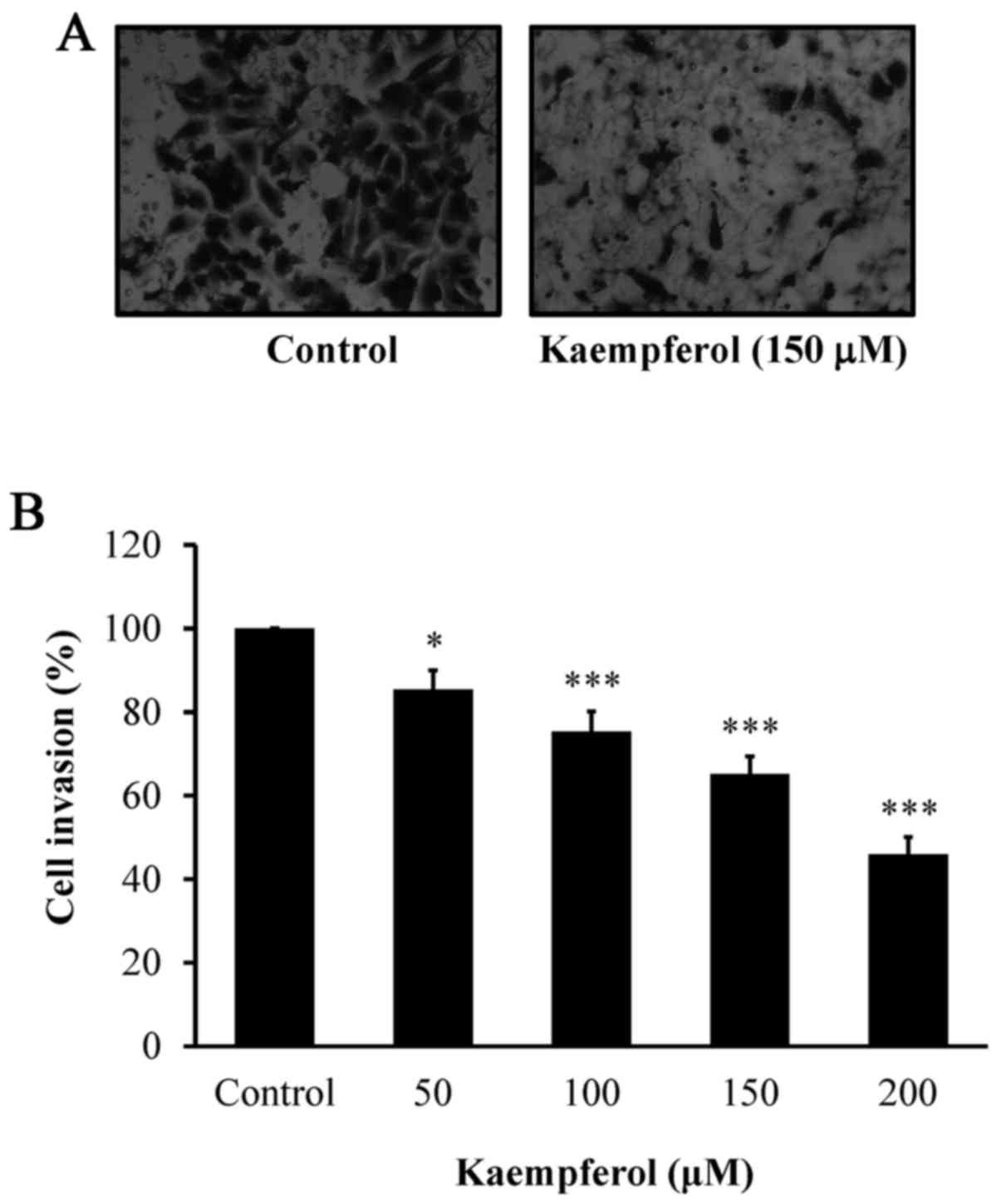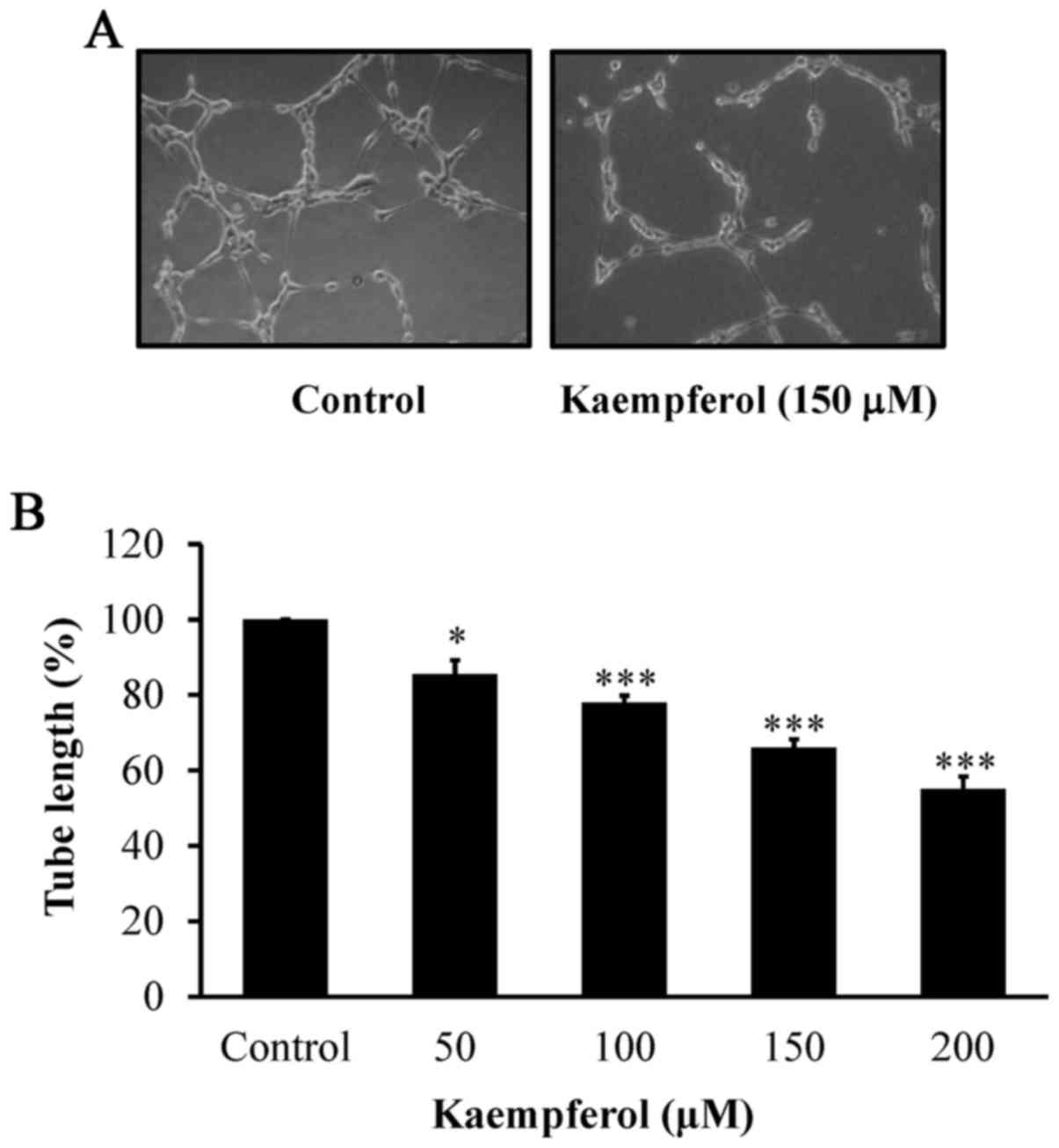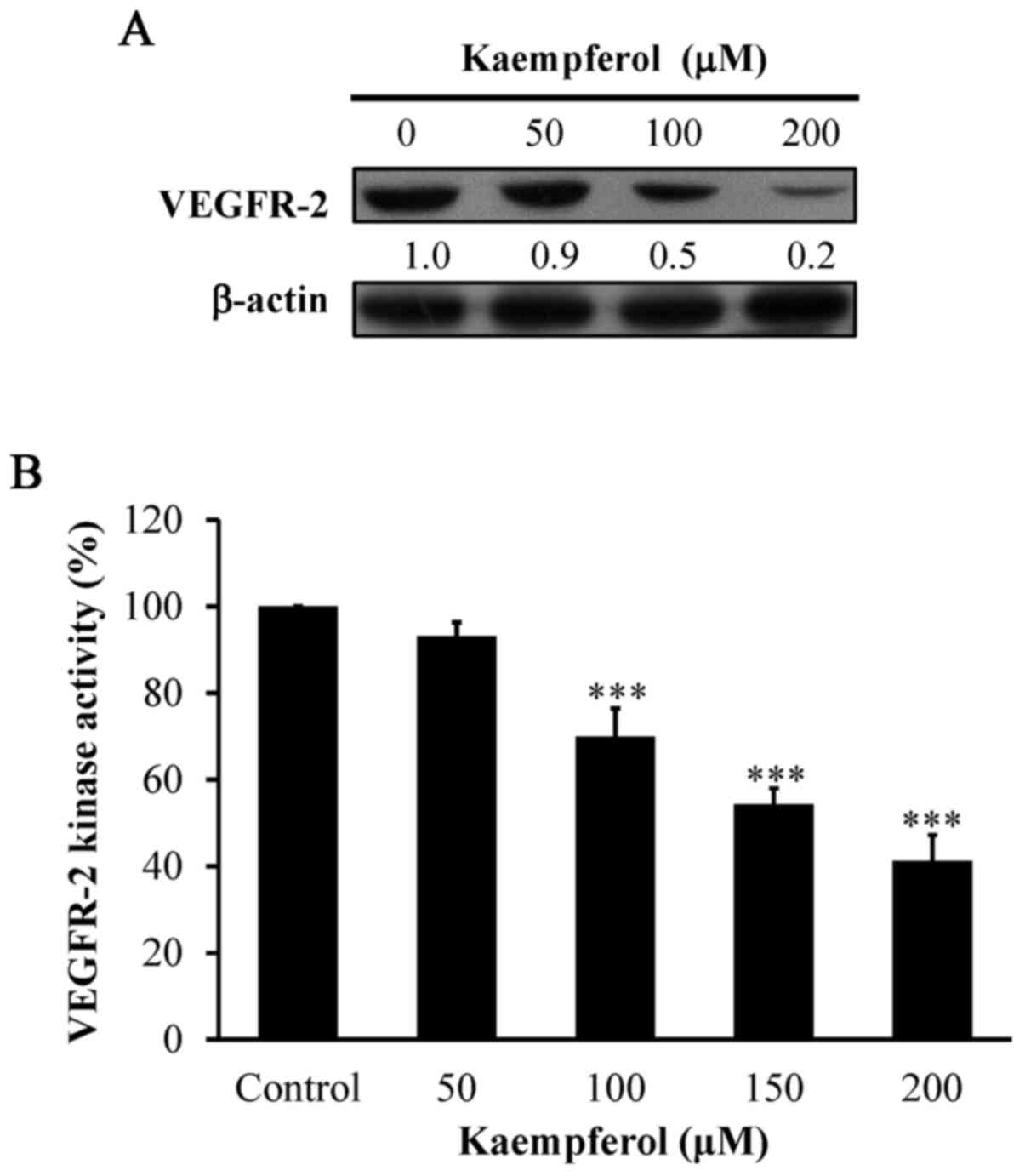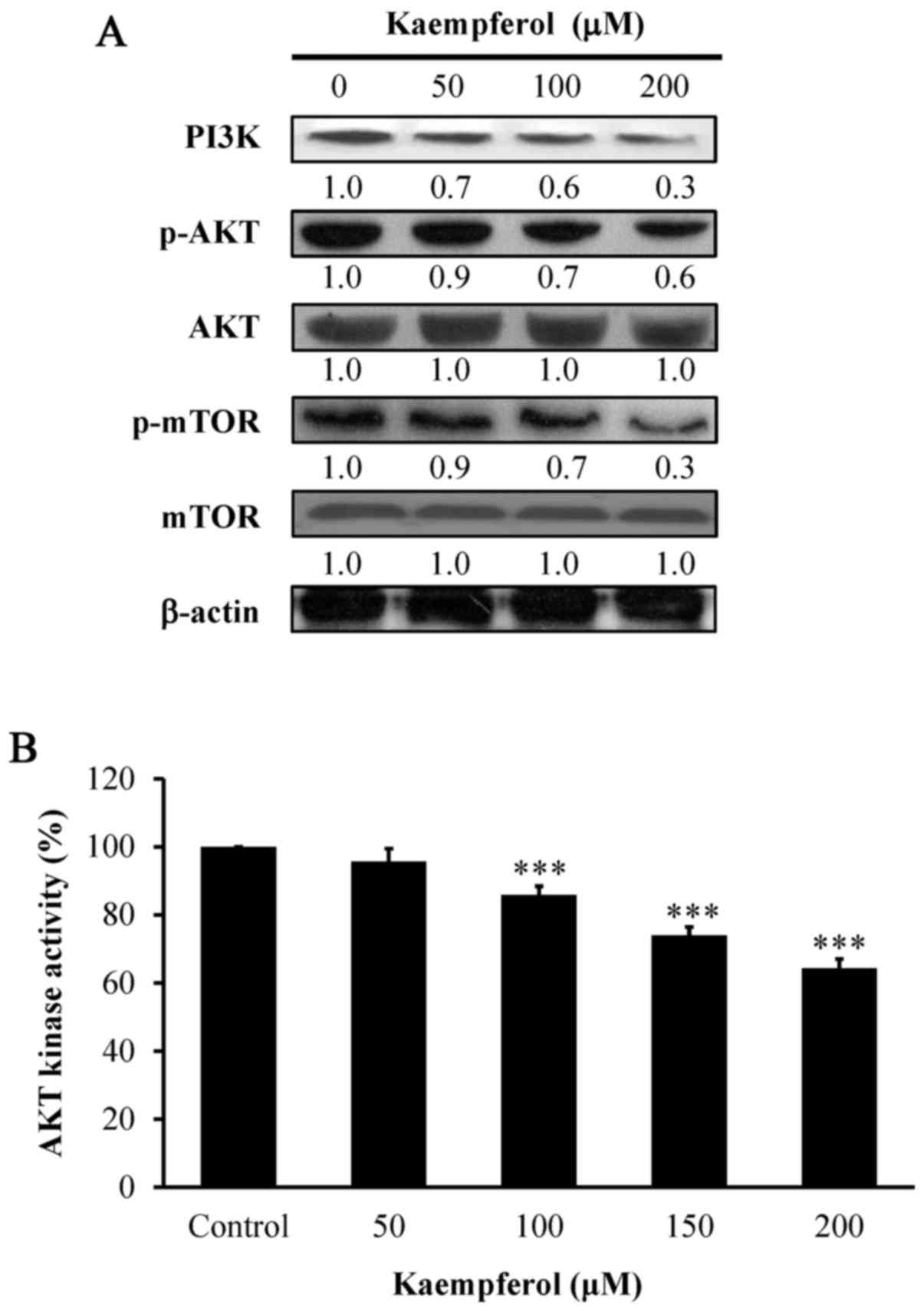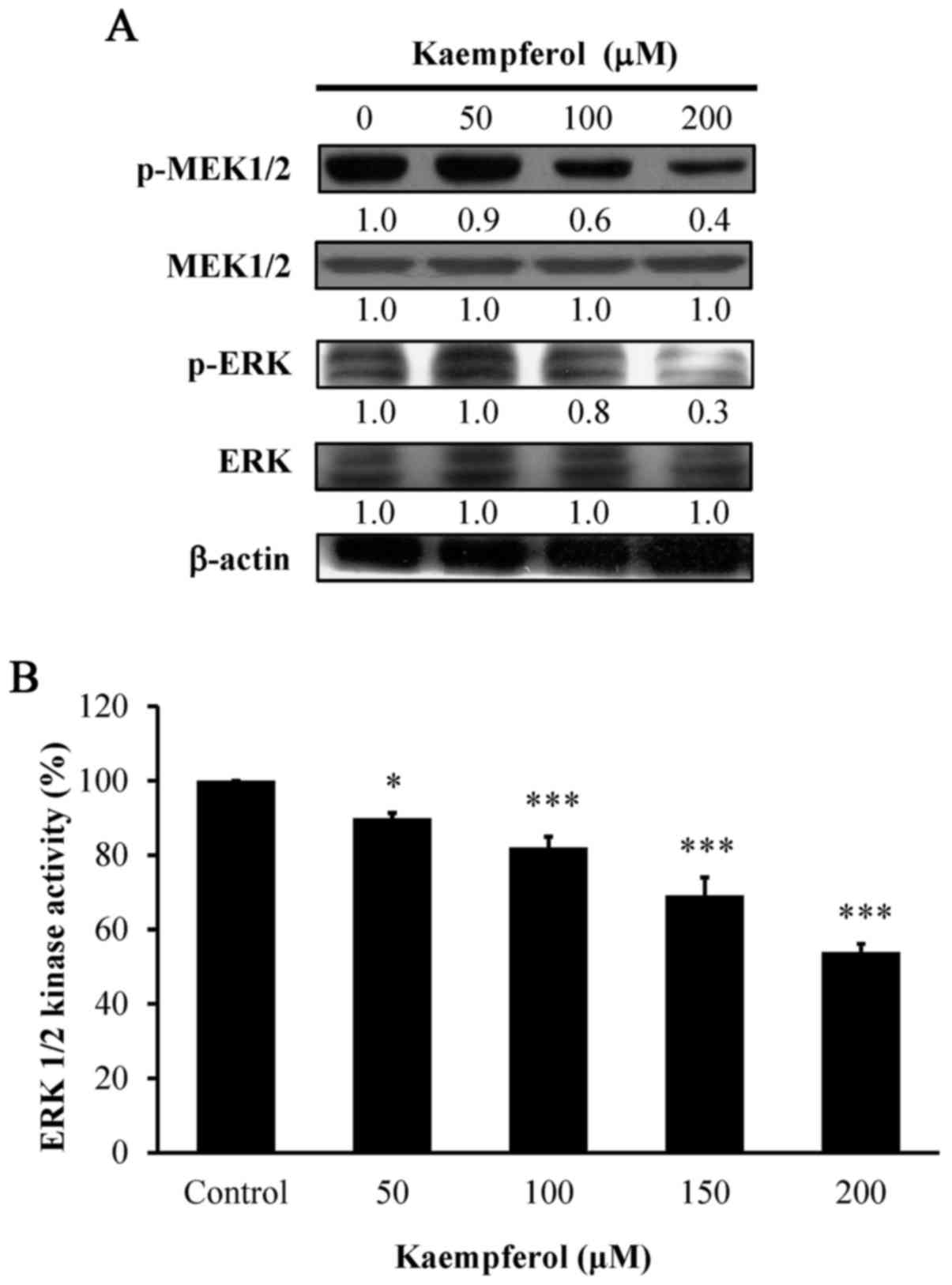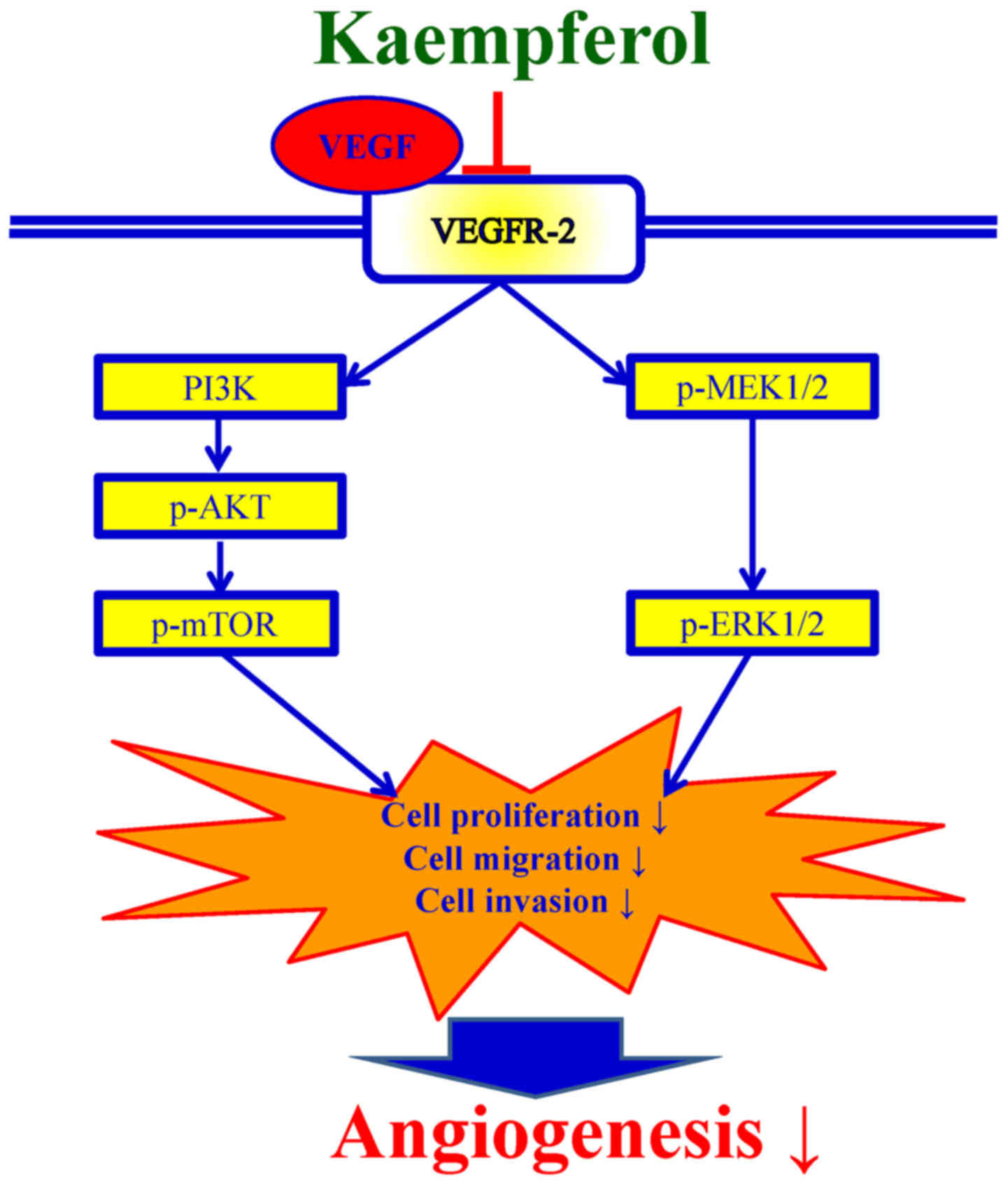Kaempferol inhibits angiogenic ability by targeting VEGF receptor-2 and downregulating the PI3K/AKT, MEK and ERK pathways in VEGF-stimulated human umbilical vein endothelial cells
- Authors:
- Published online on: March 14, 2018 https://doi.org/10.3892/or.2018.6312
- Pages: 2351-2357
Abstract
Introduction
Anti-angiogenesis is becoming a very promising goal for cancer therapy (1,2). Angiogenesis is a new passageway from pre-existing blood vessels and an essential step involved in physiological and tumor pathological processes (1,3). Tumor cell growth and metastases processes depend on the induction of a satisfactory blood support (1,4). Many chemotherapeutic agents such as paclitaxel (Taxol) inhibit tumor cell growth, proliferation and induce apoptotic cell death in cancer treatment. Furthermore, the blocking of angiogenesis provides a novel therapeutic target against tumor cells (5,6). In clinical anti-angiogenic therapy, bevacizumab (Avastin) is a monoclonal antibody for anti-vascular endothelial growth factor (VEGF) that counteracts the action of VEGF and inhibits tumor angiogenesis (7,8). Numerous phytochemicals, such as curcumin or epigallocatechin-3-gallate (EGCG) have been demonstrated to exert anti-angiogenic bioactivities in several in vitro and in vivo models (9–11). Thus, identification of phytochemicals with non-cytotoxic effects on normal cells and effective anti-angiogenic action could be of great clinical significance (11–13).
Kaempferol is a flavonoid phytochemical found in fruits and vegetables and in some traditional Chinese medicines (TCM) (14–16). Kaempferol has been reported to exert biological activities such as anti-inflammatory (17,18), antioxidant (19,20), cardioprotective (19) and antitumor (21–23). Kaempferol has been demonstrated to provide chemopreventive effects on different tumor systems including tumor initiation, promotion, and progression (24,25). Recently, our previous study revealed that kaempferol caused endoplasmic reticulum stress and mitochondria-dependent apoptosis in human osteosarcoma U-2 OS cells (26) and triggered AMPK and AKT-dependent autophagic cell death in human hepatocarcinoma SK-HEP-1 cells (27). In addition, we also demonstrated that kaempferol suppressed U-2 OS cell metastasis through suppression of the ERK/p38/JNK and AP-1 signaling pathways (28). In an anti-angiogenic study, our earlier research indicated that kaempferol induced ROS-mediated p53/ATM-dependent apoptosis in human umbilical vein endothelial cells (HUVECs) (29). However, there is no available information regarding the possible major target and anti-angiogenic mechanism of kaempferol in endothelial cells. In the present study, we analyzed the anti-angiogenic effects of kaempferol on HUVECs. Our results demonstrated that kaempferol inhibited HUVEC proliferation, migration and tube formation. The molecular levels indicated that kaempferol suppressed VEGF receptor-2 (VEGFR-2) expression and its downstream signaling cascades (AKT/mTOR and MEK/ERK) in HUVECs.
Materials and methods
Chemicals and reagents
Kaempferol, 3-(4,5-dimethylthiazol-2-yl)-2,5-diphenyltetrazolium bromide (MTT), vascular endothelial growth factor (VEGF), the other chemicals and reagents were purchased from Sigma-Aldrich (St. Louis, MO, USA) unless otherwise stated. Medium 200, Low Serum Growth Supplement (LSGS) and Trypsin-EDTA were obtained from Thermo Fisher Scientific, Inc. (Carlsbad, CA, USA). The primary antibodies [VEGFR-2 (cat. no. sc-504), PI3K (cat. no. sc-1637), p-AKT (Ser473) (cat. no. sc-7985-R), AKT (cat. no. sc-1618), p-mTOR (Ser2448) (cat. no. sc-101738), mTOR (cat. no. sc-8319), p-MEK1/2 (Ser218/Ser222) (cat. no. sc-7995), MEK1/2 (cat. no. sc-436), p-ERK (Thr202/Tyr204) (cat. no. sc-16982), ERK (cat. no. sc-135900) and β-actin (cat. no. sc-47778)] and secondary antibodies against goat anti-mouse (cat. no. sc-2005)/-rabbit (cat. no. sc-2004) and mouse anti-goat (cat. no. sc-2354) immunoglobulin (IgG)-horseradish peroxidase (HRP) were obtained from Santa Cruz Biotechnology (Santa Cruz, CA, USA).
Cell culture
HUVECs were obtained from the Bioresources Collection and Research Center (BCRC), Food Industry Research and Development Institute (Hsinchu, Taiwan). The cells were cultured in Medium 200 and LSGS in a humidified atmosphere containing 5% CO2 and 95% air at 37°C. The cells were applied within the second to fifth passages, and all assays performed used the same culture media with 50 ng/ml VEGF.
Cytotoxic assay
VEGF-stimulated HUVECs (1×104 cells/100 µl/well) were seeded into 96-well microplates and then incubated with or without 50, 100, 150 and 200 µM of kaempferol for 24 h. Cell viability was detected by MTT assay as previously described (27,28). Briefly, as soon as kaempferol exposure was completed, 10 µl MTT solution (5 mg/ml) was added to each well, and the plate was incubated for an additional 3 h. The purple crystals were dissolved with the addition of 100 µl DMSO. The optical density ratio was assessed spectrophotometrically at 570 nm. The percentage of cell viability at each concentration relative to the untreated control group (% of control) was plotted.
Wound healing migration assay
HUVECs were plated into 6-well plates and incubated to 90% confluence for 24 h. A linear wound was scratched using a 200-µl pipette tip through the monolayer before cellular debris was removed. Then, VEGF-stimulated HUVECs were exposed to 50, 100, 150 and 200 µM of kaempferol for 24 h. The healing process was captured using a phase-contract microscope after the wound was introduced prior to kaempferol incubation. Cell migration was determined from the images of five random fields. The gap size was analyzed by NIH ImageJ version 1.46 for Windows between the migrating cells from the opposing wound edge, and the data were expressed as the % of the initial gap size as previously described (30,31).
Boyden chamber Transwell assay
Cell invasion ability was detected as previously described (31,32). The Transwell (Millicell Cell Culture Insert; EMD Millipore, Billerica, MA, USA) with 8-µm polycarbonate filters was used after being pre-coated with Matrigel (2 mg/ml, 20 µl; BD Biosciences, Bedford, MA, USA) for 2 h at room temperature. VEGF-stimulated HUVECs (4×103 cells/0.4 ml culture medium) were seeded onto the upper compartment prior to 50, 100, 150 and 200 µM of kaempferol treatment for 24 h. The cells were then fixed with 4% paraformaldehyde in PBS and then stained with 2% crystal violet. The invading cells were counted under a light microscope before quantification with NIH ImageJ version 1.46 for Windows.
Tube formation assay
HUVECs were placed at a density of 5×104 cells/well into 24-well flat-bottomed plates after Matrigel (BD Biosciences) pre-coating at 37°C for 30 min. The VEGF-stimulated HUVECs (5×104 cells) thereafter were treated with or without 50, 100, 150 and 200 µM of kaempferol for 24 h. After exposure, HUVEC tube or network formation was evaluated using a phase-contrast microscope as previously described (33,34).
VEGFR-2, AKT and ERK1/2 kinase assay
VEGF-stimulated HUVECs (5×106 cells/75T flask) were incubated with or without 50, 100, 150 and 200 µM of kaempferol. After incubation for 6 h, the cells were lysed, and the activity of VEGFR-2, AKT and ERK1/2 kinase was determined in accordance with the manufacturer's instructions provided in the AKT Kinase Assay kit (Nonradioactive), the p44/42 MAP Kinase Assay kit (Nonradioactive) and the HTScan VEGF Receptor 2 Kinase Assay kit, respectively (Cell Signaling Technology, Inc., Danvers, MA, USA). Consequently, the purified samples were loaded on 12% SDS-PAGE to detect targeting proteins by immunoblotting analysis as previously described (35,36).
Western blot analysis
VEGF-stimulated HUVECs (5×106 cells/75T flask) were exposed to 50, 100 and 200 µM of kaempferol for 6 h. After being harvested and lysed, the protein concentration was assessed with the Bio-Rad Protein Assay kit (Bio-Rad Laboratories, Inc., Hercules, CA, USA). Quantified protein lysates (40 µg) were subjected to 10–12% SDS-polyacrylamide electrophoresis (SDS-PAGE) gels to separate protein extracts as detailed by our previous studies (37,38). The primary antibodies (VEGFR-2, PI3K, p-AKT, AKT, p-mTOR, mTOR, p-MEK1/2, MEK1/2, p-ERK and ERK, at 1:1,000 dilution) were hybridized overnight at 4°C, followed by the appropriate HRP-conjugated secondary antibodies (1:5,000 dilution) that were used before the electrochemiluminescence (ECL) reagent (Immobilon Western HRP substrate kit; Merck Millipore, Temecula, CA, USA). The densitometric quantification of each blot was carried out using NIH ImageJ 1.46 software.
Statistical analysis
The data are presented as the means ± standard deviation (SD) from at least three separate experiments. Statistical data was analyzed using Student's t-test, and statistical significance was considered to be P<0.05 and P<0.001.
Results
Kaempferol reduces HUVEC viability
First, VEGF-stimulated HUVECs after 0, 50, 100, 150 and 200 µM of kaempferol exposure for 24 h were assessed for growth inhibition and cytotoxicity. Our results indicated that kaempferol significantly decreased viable VEGF-stimulated HUVECs, and this effect was in a concentration-dependent manner (Fig. 1).
Kaempferol inhibits cell migration and invasion, as well as disrupts tube formation in VEGF-stimulated HUVECs
To explore the anti-angiogenic effects of kaempferol in vitro, its inhibitory influences on VEGF-induced tube formation and migration were investigated. Our data demonstrated that kaempferol concentration-dependently suppressed cell migration as determined by wound healing assay (Fig. 2A and B). Kaempferol also significantly suppressed cell invasion (Fig. 3A and B) in a concentration-dependent manner. To detect tube formation by endothelial cells, kaempferol at 50, 100, 150 and 200 µM was added for 24 h. The results revealed that kaempferol markedly disrupted the tube-like structures and network formation (Fig. 4A and B), and this effect was concentration-dependent. Therefore, we determined that kaempferol exhibits anti-angiogenic effects on VEGF-stimulated HUVECs in vitro.
Kaempferol suppresses VEGFR-2 signaling in VEGF-stimulated HUVECs
To clarify whether the angiogenic suppression requires VEGFR-2 signaling in kaempferol-treated HUVECs, the level of VEGFR-2 was detected. The protein level of VEGFR-2 (Fig. 5A) and kinase activity (Fig. 5B) were markedly suppressed by kaempferol exposure in a concentration-dependent manner. Our data demonstrated that kaempferol-inhibited angiogenesis may be involved in VEGFR-2 signaling in VEGF-stimulated HUVECs.
Kaempferol alters abundance of PI3K/AKT/mTOR signaling in VEGF-stimulated HUVECs
To determine the major pathway involved in the anti-angiogenic effect of kaempferol, we detected PI3K/AKT/mTOR signaling after kaempferol treatment at 6 h. Our results indicated that the protein levels of PI3K, and phosphorylation of both AKT and mTOR were significantly decreased in a concentration-dependent manner (Fig. 6A). The results revealed that PI3K/AKT/mTOR signaling contributed to the kaempferol-induced angiogenic effects on VEGF-stimulated HUVECs.
Kaempferol affects the protein levels of phosphorylation of MEK and ERK signaling in VEGF-stimulated HUVECs
We next aimed to clarify whether kaempferol-induced anti-angiogenesis in HUVECs was mediated mainly through phosphorylation of the MEK and ERK pathways. To demonstrate this, we further investigated the protein levels of phosphorylated MEK and phosphorylated ERK and determined that both were significantly decreased in a concentration-dependent manner after kaempferol exposure (Fig. 7A). The finding demonstrated that kaempferol attenuated angiogenesis on VEGF-stimulated HUVECs through the MEK1/2 and ERK pathways.
Kaempferol inhibits AKT and ERK kinases in VEGF-stimulated HUVECs
To determine whether AKT and ERK activities are involved in HUVECs, we assessed the kinase activities of AKT and ERK. AKT kinase (Fig. 6B) and ERK1/2 kinase (Fig. 7B) activities were concentration-dependently suppressed by kaempferol exposure. Therefore, we provide direct evidence that kaempferol inhibited angiogenic effects by blocking AKT and ERK signaling in VEGF-stimulated HUVECs.
Discussion
Flavonoids are important phytochemicals found in foods like fruits, vegetables, wine and tea (14–16,39). Notably, kaempferol is a flavonoid phytochemical, which exists in a variety of fruits and vegetables, including onions, kale, broccoli, apples, cherries, berries, tea and red wine (40,41). Kaempferol has multiple bioactivities, including antitumor effects, an antioxidant activity, and an anti-inflammatory function (17–20). In addition, kaempferol has induced apoptotic and autophagic cell death and/or cell cycle arrest in various tumor cell lines, including colon, liver, gastric and bladder cancer cells (25,27,42–47). Kim et al (48) first demonstrated that kaempferol modulated angiogenesis and immune-endothelial cell adhesion. Zhao et al (49) revealed that kaempferol from Pu-erh tea had anti-colorectal tumor cells and anti-angiogenesis effects on HUVECs. However, the target and molecular mechanism involved in the anti-angiogenic effects of kaempferol are still unknown. Notably, cell migration, invasion, tube formation and proliferation of endothelial cells are necessary processes during tumor angiogenesis (1,12,50). In the present study, we are the first to report that kaempferol at 50, 100, 150 and 200 µM inhibited VEGF-stimulated HUVEC cell proliferation (Fig. 1), inhibited cell migration (Fig. 2) and invasion (Fig. 3), and these effects were vital factors in angiogenic activity. Markedly, kaempferol inhibited tube formation (Fig. 4) in VEGF-stimulated HUVECs. Our results revealed that kaempferol triggered anti-angiogenic activity in VEGF-stimulated HUVECs, and this finding is in agreement with our previous study by our research group (29).
It is well known that vascular endothelial growth factor (VEGF) stimulates VEGF receptor further to activate its kinase activity which is a serious step in initiated tumor angiogenesis (51). Suppression of angiogenesis through the blocking of the VEGF/VEGFR signaling pathway has developed as a potential approach in antitumor therapy (51,52). VEGFR family members include KDR (kinase insert domain-containing receptor; VEGFR-2), FLT1 (Fms-like tyrosine kinase; VEGFR-1), and FLT4 (VEGFR-3) (51). VEGFR-2 binds VEGF-A, which is expressed in vascular endothelial cells and hematopoietic stem cells (53). In the present study, we focused on VEGFR-2 and its downstream signaling in kaempferol-treated HUVECs. Our results demonstrated that kaempferol triggered anti-angiogenic activity in VEGF-stimulated HUVECs by decreasing the VEGFR-2 protein level (Fig. 5A) and kinase activity (Fig. 5B). It has been documented that Y1175 and Y1214 in human VEGFR-2 are the main auto-phosphorylation sites following VEGF binding, and the activation of several downstream pathways, including PI3K/AKT and MEK/ERK levels (54,55). Our results revealed that kaempferol also reduced VEGFR-2 downstream protein levels, including PI3K, p-AKT, p-mTOR (Fig. 6A) and p-MEK1/2, p-ERK1/2 signaling (Fig. 7A). In addition, kaempferol also reduced AKT and ERK1/2 kinase activity (Figs. 6B and 7B). Our findings revealed that the kaempferol-inhibited angiogenic effects on VEGF-stimulated HUVECs may require VEGR-2 signaling.
In conclusion, these data clearly revealed the molecular signaling pathway in VEGF-stimulated HUVECs induced by kaempferol as summarized in Fig. 8. These findings provide evidence demonstrating the anti-angiogenic activity of kaempferol, and we suggest that kaempferol which is a phytochemical may act as an angiogenesis inhibitor for cancer treatment in the near future.
Acknowledgements
Not applicable.
References
|
Varinska L, Kubatka P, Mojzis J, Zulli A, Gazdikova K, Zubor P, Büsselberg D, Caprnda M, Opatrilova R, Gasparova I, et al: Angiomodulators in cancer therapy: New perspectives. Biomed Pharmacother. 89:578–590. 2017. View Article : Google Scholar : PubMed/NCBI | |
|
Aalders KC, Tryfonidis K, Senkus E and Cardoso F: Anti-angiogenic treatment in breast cancer: Facts, successes, failures and future perspectives. Cancer Treat Rev. 53:98–110. 2017. View Article : Google Scholar : PubMed/NCBI | |
|
Markowska A, Sajdak S, Markowska J and Huczyński A: Angiogenesis and cancer stem cells: New perspectives on therapy of ovarian cancer. Eur J Med Chem. 142:87–94. 2017. View Article : Google Scholar : PubMed/NCBI | |
|
Lupo G, Caporarello N, Olivieri M, Cristaldi M, Motta C, Bramanti V, Avola R, Salmeri M, Nicoletti F and Anfuso CD: Anti-angiogenic therapy in cancer: Downsides and new pivots for precision medicine. Front Pharmacol. 7:5192017. View Article : Google Scholar : PubMed/NCBI | |
|
Ai B, Bie Z, Zhang S and Li A: Paclitaxel targets VEGF-mediated angiogenesis in ovarian cancer treatment. Am J Cancer Res. 6:1624–1635. 2016.PubMed/NCBI | |
|
Allegrini G, Coltelli L, Orlandi P, Fontana A, Camerini A, Ferro A, Cazzaniga M, Casadei V, Lucchesi S, Bona E, et al: Pharmacogenetic interaction analysis of VEGFR-2 and IL-8 polymorphisms in advanced breast cancer patients treated with paclitaxel and bevacizumab. Pharmacogenomics. 15:1985–1999. 2014. View Article : Google Scholar : PubMed/NCBI | |
|
Sini V, Cassano A, Corsi D, De Laurentiis M, Gamucci T, Mauri M, Naso G, Roselli M, Ruggeri EM, Tonini G, et al: Bevacizumab as first-line treatment in HER2-negative advanced breast cancer: Pros and cons. Tumori. 102:472–480. 2016. View Article : Google Scholar : PubMed/NCBI | |
|
Pentheroudakis G, Kotoula V, Kouvatseas G, Charalambous E, Dionysopoulos D, Zagouri F, Koutras A, Papazisis K, Pectasides D, Samantas E, et al: Association of VEGF-A splice variant mRNA expression with outcome in bevacizumab-treated patients with metastatic breast cancer. Clin Breast Cancer. 14:330–338. 2014. View Article : Google Scholar : PubMed/NCBI | |
|
Abd El-Rahman SS, Shehab G and Nashaat H: Epigallocatechin-3-Gallate: The prospective targeting of cancer stem cells and preventing metastasis of chemically-induced mammary cancer in rats. Am J Med Sci. 354:54–63. 2017. View Article : Google Scholar : PubMed/NCBI | |
|
Walczak K, Marciniak S and Rajtar G: Cancer chemoprevention-selected molecular mechanisms. Postepy Hig Med Dosw. 71:149–161. 2017. View Article : Google Scholar | |
|
Saberi-Karimian M, Katsiki N, Caraglia M, Boccellino M, Majeed M and Sahebkar A: Vascular endothelial growth factor: An important molecular target of curcumin. Crit Rev Food Sci Nutr. 1–14. 2017. View Article : Google Scholar : PubMed/NCBI | |
|
Bhattacharjee S and Mandal DP: Angiogenesis modulation: The ‘spice effect’. J Environ Pathol Toxicol Oncol. 31:273–283. 2012. View Article : Google Scholar : PubMed/NCBI | |
|
Wang S, Shen P, Zhou J and Lu Y: Diet phytochemicals and cutaneous carcinoma chemoprevention: A review. Pharmacol Res. 119:327–346. 2017. View Article : Google Scholar : PubMed/NCBI | |
|
Kilari EK and Putta S: Biological and phytopharmacological descriptions of litchi chinensis. Pharmacogn Rev. 10:60–65. 2016. View Article : Google Scholar : PubMed/NCBI | |
|
Chen AY and Chen YC: A review of the dietary flavonoid, kaempferol on human health and cancer chemoprevention. Food Chem. 138:2099–2107. 2013. View Article : Google Scholar : PubMed/NCBI | |
|
Murakami A and Ohnishi K: Target molecules of food phytochemicals: Food science bound for the next dimension. Food Funct. 3:462–476. 2012. View Article : Google Scholar : PubMed/NCBI | |
|
Zhang R, Ai X, Duan Y, Xue M, He W, Wang C, Xu T, Xu M, Liu B, Li C, et al: Kaempferol ameliorates H9N2 swine influenza virus-induced acute lung injury by inactivation of TLR4/MyD88-mediated NF-κB and MAPK signaling pathways. Biomed Pharmacother. 89:660–672. 2017. View Article : Google Scholar : PubMed/NCBI | |
|
Zhuang Z, Ye G and Huang B: Kaempferol alleviates the interleukin-1β-induced inflammation in rat osteoarthritis chondrocytes via suppression of NF-κB. Med Sci Monit. 23:3925–3931. 2017. View Article : Google Scholar : PubMed/NCBI | |
|
Duan L, Ding W, Liu X, Cheng X, Cai J, Hua E and Jiang H: Biosynthesis and engineering of kaempferol in Saccharomyces cerevisiae. Microb Cell Fact. 16:1652017. View Article : Google Scholar : PubMed/NCBI | |
|
Han S, Nguyen Hanh TT, Hur J, Kim NM, Kim SB, Hwang KH, Moon YH, Kang C, Chung B, Kim YM, et al: Synthesis and characterization of novel astragalin galactosides using β-galactosidase from Bacillus circulans. Enzyme Microb Technol. 103:59–67. 2017. View Article : Google Scholar : PubMed/NCBI | |
|
Hung TW, Chen PN, Wu HC, Wu SW, Tsai PY, Hsieh YS and Chang HR: Kaempferol inhibits the invasion and migration of renal cancer cells through the downregulation of AKT and FAK pathways. Int J Med Sci. 14:984–993. 2017. View Article : Google Scholar : PubMed/NCBI | |
|
Kashafi E, Moradzadeh M, Mohamadkhani A and Erfanian S: Kaempferol increases apoptosis in human cervical cancer HeLa cells via PI3K/AKT and telomerase pathways. Biomed Pharmacother. 89:573–577. 2017. View Article : Google Scholar : PubMed/NCBI | |
|
Lee GA, Choi KC and Hwang KA: Kaempferol, a phytoestrogen, suppressed triclosan-induced epithelial-mesenchymal transition and metastatic-related behaviors of MCF-7 breast cancer cells. Environ Toxicol Pharmacol. 49:48–57. 2017. View Article : Google Scholar : PubMed/NCBI | |
|
Okoye FB, Sawadogo WR, Sendker J, Aly AH, Quandt B, Wray V, Hensel A, Esimone CO, Debbab A, Diederich M and Proksch P: Flavonoid glycosides from Olax mannii: Structure elucidation and effect on the nuclear factor kappa B pathway. J Ethnopharmacol. 176:27–34. 2015. View Article : Google Scholar : PubMed/NCBI | |
|
Song W, Dang Q, Xu D, Chen Y, Zhu G, Wu K, Zeng J, Long Q, Wang X, He D and Li L: Kaempferol induces cell cycle arrest and apoptosis in renal cell carcinoma through EGFR/p38 signaling. Oncol Rep. 31:1350–1356. 2014. View Article : Google Scholar : PubMed/NCBI | |
|
Huang WW, Chiu YJ, Fan MJ, Lu HF, Yeh HF, Li KH, Chen PY, Chung JG and Yang JS: Kaempferol induced apoptosis via endoplasmic reticulum stress and mitochondria-dependent pathway in human osteosarcoma U-2 OS cells. Mol Nutr Food Res. 54:1585–1595. 2010. View Article : Google Scholar : PubMed/NCBI | |
|
Huang WW, Tsai SC, Peng SF, Lin MW, Chiang JH, Chiu YJ, Fushiya S, Tseng MT and Yang JS: Kaempferol induces autophagy through AMPK and AKT signaling molecules and causes G2/M arrest via downregulation of CDK1/cyclin B in SK-HEP-1 human hepatic cancer cells. Int J Oncol. 42:2069–2077. 2013. View Article : Google Scholar : PubMed/NCBI | |
|
Chen HJ, Lin CM, Lee CY, Shih NC, Peng SF, Tsuzuki M, Amagaya S, Huang WW and Yang JS: Kaempferol suppresses cell metastasis via inhibition of the ERK-p38-JNK and AP-1 signaling pathways in U-2 OS human osteosarcoma cells. Oncol Rep. 30:925–932. 2013. View Article : Google Scholar : PubMed/NCBI | |
|
Lee CF, Yang JS, Tsai FJ, Chiang NN, Lu CC, Huang YS, Chen C and Chen FA: Kaempferol induces ATM/p53-mediated death receptor and mitochondrial apoptosis in human umbilical vein endothelial cells. Int J Oncol. 48:2007–2014. 2016. View Article : Google Scholar : PubMed/NCBI | |
|
Yang JS, Lin CA, Lu CC, Wen YF, Tsai FJ and Tsai SC: Carboxamide analog ITR-284 evokes apoptosis and inhibits migration ability in human lung adenocarcinoma A549 cells. Oncol Rep. 37:1786–1792. 2017. View Article : Google Scholar : PubMed/NCBI | |
|
Tsai SC, Tsai MH, Chiu CF, Lu CC, Kuo SC, Chang NW and Yang JS: AMPK-dependent signaling modulates the suppression of invasion and migration by fenofibrate in CAL 27 oral cancer cells through NF-κB pathway. Environ Toxicol. 31:866–876. 2016. View Article : Google Scholar : PubMed/NCBI | |
|
Goodwin CR, Lal B, Zhou X, Ho S, Xia S, Taeger A, Murray J and Laterra J: Cyr61 mediates hepatocyte growth factor-dependent tumor cell growth, migration, and Akt activation. Cancer Res. 70:2932–2941. 2010. View Article : Google Scholar : PubMed/NCBI | |
|
Lu CC, Chen HP, Chiang JH, Jin YA, Kuo SC, Wu TS, Hour MJ, Yang JS and Chiu YJ: Quinazoline analog HMJ-30 inhibits angiogenesis: Involvement of endothelial cell apoptosis through ROS-JNK-mediated death receptor 5 signaling. Oncol Rep. 32:597–606. 2014. View Article : Google Scholar : PubMed/NCBI | |
|
Chiang JH, Yang JS, Lu CC, Hour MJ, Chang SJ, Lee TH and Chung JG: Newly synthesized quinazolinone HMJ-38 suppresses angiogenetic responses and triggers human umbilical vein endothelial cell apoptosis through p53-modulated Fas/death receptor signaling. Toxicol Appl Pharmacol. 269:150–162. 2013. View Article : Google Scholar : PubMed/NCBI | |
|
Fujita H, Gomori A, Fujioka Y, Kataoka Y, Tanaka K, Hashimoto A, Suzuki T, Ito K, Haruma T, Yamamoto-Yokoi H, et al: High potency VEGFRs/MET/FMS triple blockade by TAS-115 concomitantly suppresses tumor progression and bone destruction in tumor-induced bone disease model with lung carcinoma cells. PLoS One. 11:e01648302016. View Article : Google Scholar : PubMed/NCBI | |
|
Pu K, Yuan L, Chen L, Wang A, Zhou X, Zhang H and Zhu Y: Identification of VEGFR2-binding peptides using high throughput bacterial display methods and functional assessment. Curr Cancer Drug Targets. 15:158–170. 2015. View Article : Google Scholar : PubMed/NCBI | |
|
Yang JS, Hour MJ, Huang WW, Lin KL, Kuo SC and Chung JG: MJ-29 inhibits tubulin polymerization, induces mitotic arrest, and triggers apoptosis via cyclin-dependent kinase 1-mediated Bcl-2 phosphorylation in human leukemia U937 cells. J Pharmacol Exp Ther. 334:477–488. 2010. View Article : Google Scholar : PubMed/NCBI | |
|
Lee MR, Lin C, Lu CC, Kuo SC, Tsao JW, Juan YN, Chiu HY, Lee FY, Yang JS and Tsai FJ: YC-1 induces G0/G1 phase arrest and mitochondria-dependent apoptosis in cisplatin-resistant human oral cancer CAR cells. Biomedicine. 7:122017. View Article : Google Scholar : PubMed/NCBI | |
|
Davatgaran-Taghipour Y, Masoomzadeh S, Farzaei MH, Bahramsoltani R, Karimi-Soureh Z, Rahimi R and Abdollahi M: Polyphenol nanoformulations for cancer therapy: Experimental evidence and clinical perspective. Int J Nanomedicine. 12:2689–2702. 2017. View Article : Google Scholar : PubMed/NCBI | |
|
Liu RH: Health-promoting components of fruits and vegetables in the diet. Adv Nutr. 4 Suppl:S384–S392. 2013. View Article : Google Scholar | |
|
Arif H, Sohail A, Farhan M, Rehman AA, Ahmad A and Hadi SM: Flavonoids-induced redox cycling of copper ions leads to generation of reactive oxygen species: A potential role in cancer chemoprevention. Int J Biol Macromol. 106:569–578. 2018. View Article : Google Scholar : PubMed/NCBI | |
|
Choi EJ and Ahn WS: Kaempferol induced the apoptosis via cell cycle arrest in human breast cancer MDA-MB-453 cells. Nutr Res Pract. 2:322–325. 2008. View Article : Google Scholar : PubMed/NCBI | |
|
Lee HS, Cho HJ, Yu R, Lee KW, Chun HS and Park JH: Mechanisms underlying apoptosis-inducing effects of Kaempferol in HT-29 human colon cancer cells. Int J Mol Sci. 15:2722–2737. 2014. View Article : Google Scholar : PubMed/NCBI | |
|
Che J, Liang B, Zhang Y, Wang Y, Tang J and Shi G: Kaempferol alleviates ox-LDL-induced apoptosis by up-regulation of autophagy via inhibiting PI3K/Akt/mTOR pathway in human endothelial cells. Cardiovasc Pathol. 31:57–62. 2017. View Article : Google Scholar : PubMed/NCBI | |
|
Varshney R, Gupta S and Roy P: Cytoprotective effect of kaempferol against palmitic acid-induced pancreatic β-cell death through modulation of autophagy via AMPK/mTOR signaling pathway. Mol Cell Endocrinol. 448:1–20. 2017. View Article : Google Scholar : PubMed/NCBI | |
|
Cho IH, Choi YJ, Gong JH, Shin D, Kang MK and Kang YH: Astragalin inhibits autophagy-associated airway epithelial fibrosis. Respir Res. 16:512015. View Article : Google Scholar : PubMed/NCBI | |
|
Huang HC, Syu KY and Lin JK: Chemical composition of Solanum nigrum linn extract and induction of autophagy by leaf water extract and its major flavonoids in AU565 breast cancer cells. J Agric Food Chem. 58:8699–8708. 2010. View Article : Google Scholar : PubMed/NCBI | |
|
Kim JD, Liu L, Guo W and Meydani M: Chemical structure of flavonols in relation to modulation of angiogenesis and immune-endothelial cell adhesion. J Nutr Biochem. 17:165–176. 2006. View Article : Google Scholar : PubMed/NCBI | |
|
Zhao X, Song JL, Kim JD, Lee JS and Park KY: Fermented Pu-erh tea increases in vitro anticancer activities in HT-29 cells and has antiangiogenetic effects on HUVECs. J Environ Pathol Toxicol Oncol. 32:275–288. 2013. View Article : Google Scholar : PubMed/NCBI | |
|
Yüksel Ş, Akyerli Boylu C and Yakicier Cengiz M: Angiogenesis, invasion, and metastasis characteristics of hepatocellular carcinoma. J Gastrointest Cancer. Aug 7–2017. View Article : Google Scholar | |
|
Ramjiawan RR, Griffioen AW and Duda DG: Anti-angiogenesis for cancer revisited: Is there a role for combinations with immunotherapy? Angiogenesis. 20:185–204. 2017. View Article : Google Scholar : PubMed/NCBI | |
|
Chebib R, Verlingue L, Cozic N, Faron M, Burtin P, Boige V, Hollebecque A and Malka D: Angiogenesis inhibition in the second-line treatment of metastatic colorectal cancer: A systematic review and pooled analysis. Semin Oncol. 44:114–128. 2017. View Article : Google Scholar : PubMed/NCBI | |
|
Wu M, Xiong H, Xu Y, Xiong X, Zou H, Zheng M, Wang X and Zhou X: Association between VEGF-A and VEGFR-2 polymorphisms and response to treatment of neovascular AMD with anti-VEGF agents: A meta-analysis. Br J Ophthalmol. 101:976–984. 2017. View Article : Google Scholar : PubMed/NCBI | |
|
Li W, Man XY, Li CM, Chen JQ, Zhou J, Cai SQ, Lu ZF and Zheng M: VEGF induces proliferation of human hair follicle dermal papilla cells through VEGFR-2-mediated activation of ERK. Exp Cell Res. 318:1633–1640. 2012. View Article : Google Scholar : PubMed/NCBI | |
|
Zhang Z, Neiva KG, Lingen MW, Ellis LM and Nör JE: VEGF-dependent tumor angiogenesis requires inverse and reciprocal regulation of VEGFR1 and VEGFR2. Cell Death Differ. 17:499–512. 2010. View Article : Google Scholar : PubMed/NCBI |



